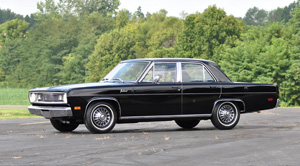
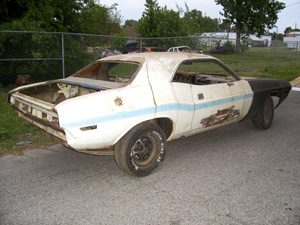
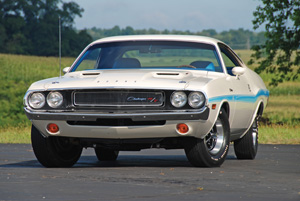
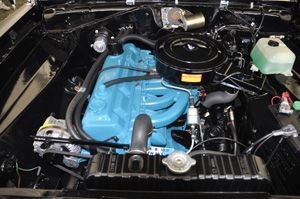
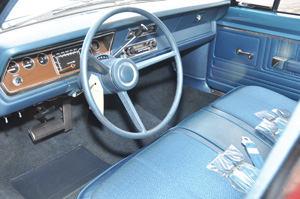
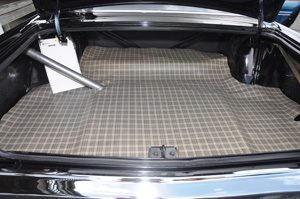 Dave Walden used to get made fun of by his older brother’s friends when he played with his Hot Wheels cars. They would come over in their brand-new 1969 Chevrolet Camaro Z28s and 1970 Pontiac Firebird Trans Ams and tease him for fooling around with toy cars.
Dave Walden used to get made fun of by his older brother’s friends when he played with his Hot Wheels cars. They would come over in their brand-new 1969 Chevrolet Camaro Z28s and 1970 Pontiac Firebird Trans Ams and tease him for fooling around with toy cars.
“But I told them, ‘Yeah, one of these days I’ll have neater cars than any of you guys,’” Walden says. “But they just laughed at me.”
Walden, however, is the one who’s laughing now. Success as the owner of ECS Automotive Concepts, a maker of certified VIN decals, tire pressure labels and emissions decals, has allowed him to indulge his passion for restoring cars to the exact condition they were in when they rolled off the assembly line – and that’s no exaggeration.
No Debate
To Walden, there is no room for debate on the true definition of restore: to bring back to original condition. Based on that definition, he believes some cars just don’t stack up.
“There are very nice cars out there that people have redone, but I think they often use the word ‘restored’ in an incorrect way,” says Walden, who calls himself an “obsessive compulsive perfectionist.” “Most of these cars are nice, but I call them modified or altered. They don’t like that because they think of modified as a big board sticking up out of the hood. But to me, modified is anything different than the original, even if it’s the refinish.”
Walden’s dedication to authenticity and originality is what led him to start making VIN labels with his company. He was restoring a 302 Boss Mustang and wanted the decals to be just like the originals, so he placed an order with the only company that made them. But when he got them, he called the company back and said no thanks because they didn’t look like the originals.
“They replied, ‘We’ve been doing this for over 20 years, and just because someone calls now and says they’re not original, we’re not going to change it,’” he said. “I was like whoa, sorry to bother you.”
Walden’s goal is to restore a car well enough to make someone looking at it scratch their head and say, “This is not a restored car.” He compares an auto restoration to a toupee. If he was wearing one, and someone came up to him and said, “I’ve been looking at you for 20 minutes, and that hair piece is so nice I almost couldn’t tell it was a toupee,” he said he would throw it into the nearest trash can and start over.
“If someone comes up and says, ‘That’s a beautiful restoration,’ they better not be saying it because they can tell it has been restored,” Walden says. “They better be saying it because they’re like, ‘There is no way this is a survivor car. We can’t tell it has been restored because it doesn’t look like a vehicle that somebody has manipulated.”
Doing It All
Walden and a team of three others – Tom Barcroft (retired Chrysler executive), Steve Been (restoration shop owner) and Dave Stuart (current Chrysler executive) – with automotive backgrounds literally do all the work on his restorations – including the cad plating, zinc plating and phosphating.
“We’re very particular and figure if you want it done right, you have to do it yourself,” he says.
They take the work to insane measures to stay to the true definition of restoration. On a 1970 Chrysler Valiant, they checked every 6 inches on every body panel with a paint micrometer and documented the results. They then wet sanded the car and took 2-1/2 mils off the original paint and sprayed the exact same amount on, creating the right texture and orange peel so that it looked like a factory-baked job.
“This is stuff that took us months to perfect with pressures in the gun and the viscosity and mix-up of paint,” says Walden. “We even went so far as to do research on the specific gravity of components such as those found in the old primers, trying to figure out overspray and how far a certain media will go under what pressure. It became more of a science project than a restoration.”
A Survivor
The Valiant was a “survivor car,” owned by a woman who was 60 years old when she bought it in 1970. It only had 9,600 miles on it and had never been touched or serviced. They had been looking for a car with no reproduction parts that was still in decent survivor condition. All the parts had to be not so far degraded that they would have to be replaced – which meant carpeting, too. The collector Walden bought it from said that even the original air was still in the tires.
They took seven photos of every fastener, nut, bolt, screw, etc., on the car while taking it apart, documenting not only the exact holes they came from but the exact position they were clocked in.
“That added 300 to 400 hours alone to the restoration,” says Walden. “But again, that’s a true restoration.”
Even the undercoating was restored, but as Walden is known to do, he took it to another extreme: formulating his own undercoating that was just like the original and reapplying it by hand.
“I took a Q-Tip with the mixture on it and dotted the bottom of the car when it was on the rotisserie,” Walden says. “I spent eight months standing 12 hours a day on the weekends doing this. It was more difficult then going through college and starting the two businesses I have combined. I’ll never do it again.”
Walden believes that there is no one in the world who is doing what he and his team are doing. Even so, he admits you can never return a car exactly to its factory condition.
“So you become an illusionist, and the illusion is to make it appear exactly like it was,” he says. “There can’t be a single pit or any signs of damage left on the car. It can’t look manipulated slated. It has to look like the vehicle that was put on the showroom floor.”
World Recognition
Proof, Walden says, of his other-worldly restoration work is the reaction by Wolfgang Blaube, renowned editor of the German car magazine Autobild, who recently got a firsthand look at his cars. Blaube said Walden and his team were crazy, while at the same time dropping to his knees when he opened the door to the Valiant.
“He rolled his eyes and said he hadn’t smelled that in 40 years,” says Walden. “His words to us were that we exemplify and represent what the word ‘restore’ means.”
Walden says he was able to restore the original smell of the interior without too much trouble. “The smell is nothing more than a conglomerate of everything, whether it be the carpeting, paints, rubbers and plastic,” he says. So he and his team acquired materials from back in that time and put them in the car, letting them permeate and absorb in the headliner and seats.
Richard Ehrenberg, editor of Mopar Action magazine, covered Walden’s Dodge Challenger project and wrote that it looked like someone went back to the year 1970, bought a vehicle brand new, loaded it into a nitrogen-filled container and unloaded it at the 2008 Nationals.
Even Jay Leno’s appraiser, Carol Roddell Jr., who restores all Leno’s motorcycles, once tried to buy Walden’s 1970 black HEMI ’Cuda. He flew in to look at his vehicles and said, “Jay would die to have the stuff you have.” The funny thing is most people don’t know about Walden’s collection because he doesn’t advertise it much. BodyShop Business, he said, will be one of only several publications that have covered it.
Current Projects
Walden’s current projects include a 1970 Concept ’Cuda and a 1969 Trans Am. With the ’Cuda, he’s building a four-door version that never made it out of the factory from old drawings. The Trans Am, of course, will be 100-percent factory original – including belts, oil filters, hoses, etc.
Walden can’t pick out a single restoration as his favorite. He says each one has taught him valuable lessons that he can apply to the
next one.
“Every restoration has been a progression, a learning experience,” he says. “The one thing I take away from this is that you could do 1,000 vehicles, and at the end of doing that, there is still something to learn. No one will ever have all the answers.”
For obvious reasons, Walden doesn’t drive his cars, although he did drive his 1969 Firebird to work the other day. That car was the first restoration he ever did, and it took him nine years, partly because he lacked the proper financing because he was still young. He followed that up with a 1987 Buick Grand National that had only 2,700 miles.
Some of the tires on his cars cost $2,000 apiece, so his wife purchased covers for them to use when rolling the vehicles on and off trailers. The tires even still have the whiskers on them. In 2006, Chrysler selected his ’70 HEMI ’Cuda to represent the corporation at the 2006 SEMA Show for the 40th anniversary of the muscle car.













